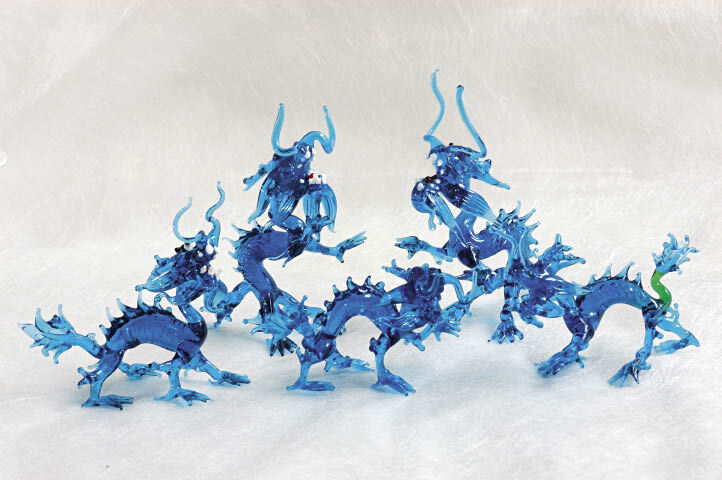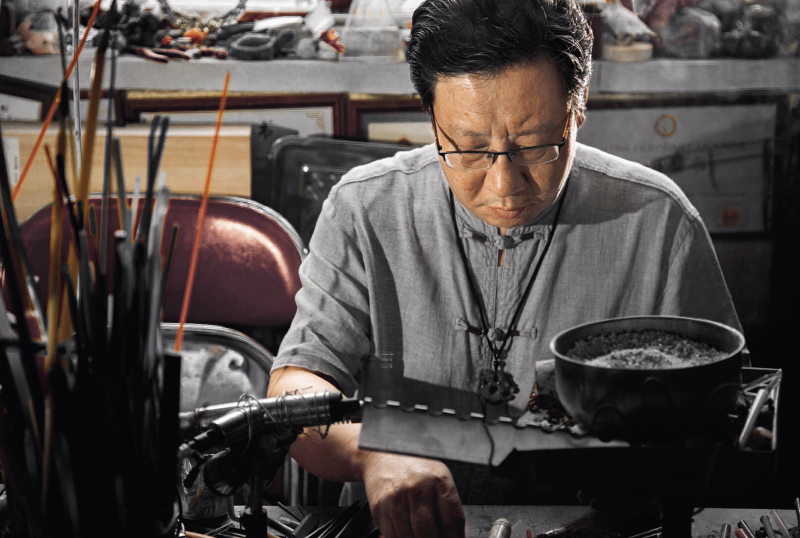
The dragon-shaped glassware is one of the most classical works of Beijing glassware. It is revered for its exquisite craftsmanship and beautiful lines.
From the Qing Dynasty to the Republic of China (1912-1949), the most common glassware handicrafts were potted flowers, snuff bottles, and various kinds of small decorations. After the founding of the People’s Republic of China in 1949, buttons, corsages, cap flowers, cigarette holders, and other more practical glassware products were born.
Among all the glassware handicrafts nationwide, Beijing glassware, with its gorgeous colors, indigenous modeling, and pureness, stands out and is favored by handicraft lovers from both home and abroad.
After more than 600 years of development, the handcraft of Beijing glassware has been passed down to the seventh generation. In 2008, Beijing glassware was added to the national intangible cultural heritage list.
Liu Yu, the seventh-generation inheritor of Beijing glassware, learned this craft from his mother, Xing Lanxiang, who is the only glassware craft master alive today. For more than 10 years, Liu Yu has been working in his studio at Baigongfang Handicrafts Museum in Dongcheng District, Beijing, devoting himself to his beloved career. He makes a living from the 1,000 beautiful pieces he produces each year, and guards the time-honored craft with great enthusiasm.
A Long History
The history of Beijing glassware can be traced back to the early Ming Dynasty (1368-1644). It is said that when people smelted bronze and elixir, they found that some waste materials could form beautiful colors. So, they began to use these materials to make handicrafts, which then became the earliest forms of glassware.
During the Ming and Qing dynasties, glassware handicrafts were mainly used as decorations for royalty and nobles. Besides, in the Qing Dynasty, they were also made into beads for the hats of officials, having different colors according to different titles. During the reign of Emperor Kangxi (1661-1722) in the Qing Dynasty, the emperor ordered the Ministry of Engineering and Industries to set up an imperial workshop inside the then Beijing glassware factory to make glassware products specially for the royal family, thus earning glassware the two nicknames of “imperial material” and “royal glassware.”
After the decline of the Qing Dynasty, the craft of making glassware went from exclusively making decorations for the royal palace to serving the common folk in society. Four big families got renowned for their glassware crafts with distinct Beijing styles. There were thousands of kinds of Beijing glassware handicrafts, ranging from daily ornaments such as jewelry to ornamental handicrafts in the shapes of birds, animals, flowers, fruits, and human figures. Among them jade-imitating glassware handicrafts could hardly be distinguished from genuine jade.
After the founding of the PRC, the central government invested enormously in Beijing glassware. Old glassware artisans were brought together and a Beijing glassware factory was set up to make decorative glassware handicrafts. Those handicrafts became leading export products at the time.
Liu Yu’s studio in Baigongfang Handicrafts Museum is the original site of the Beijing glassware factory. His mother, Xing Lanxiang, used to be the youngest artisan in the technical department of the factory at that time. He recalled that when his mother started working there, freight cars lined up outside the factory to buy glassware handicrafts. At that time, the factory earned a lot of money for the country, so much so that the central government attached great importance to it. The then Premier Zhou Enlai visited the factory many times and asked workers there to make exquisite products which could be used to show the world Chinese glassware crafts.

Liu Yu sits in his studio making Beijing glassware works. He has been doing so for decades.
However, due to various reasons including the shortage of raw materials, the factory’s internal reform, as well as changes of consumers’ tastes, like lots of other intangible cultural heritage, Beijing glassware making craft gradually declined. Only a few artisans today have a mastery of the craft.
Exquisite Workmanship
Beijing glassware is made by sculpting glass in fire. A product is finished in one go, therefore the skills of the artisan are all that are needed. This makes it necessary for him or her to be fully-prepared in advance. The image of the product to be made, the temperature of the fire…, everything in the whole process relies heavily on the artisan’s skills.
The main material is the glassware stick, or low-temperature lead glaze. To get it, workers first break rocks taken from mountains into pieces, and then burn the silicate in the smashed rocks in order to melt and remove impurities, then add different oxide metals to form a variety of colors.
There are no molds used throughout the process of making glassware products. The artisan uses scissors and tweezers to sculpt or twine the glassware sticks which are melting in fire to what they want. In the twinkling of an eye, a lovely handicraft is made. In the process, pressing, stretching, printing, dotting, and pulling are key techniques used.
In Liu Yu’s eyes, those seemingly easy steps are very energy-consuming. The designing of a good image requires that the artisan has rich experience and a good cultural background. In formal production, when the fire ignites and the stick melts, the glassware must be molded within 40 minutes, or the material will become unusable. Behind the simple steps is the meticulous, decades-long practice of the inheritor.
Passing on a Cultural Inheritance
For Liu Yu, as the inheritor of Beijing glassware, the most important thing is to pass on the original craftsmanship of the previous generations to future ones. Being the only full-time practioner of this craft today constantly makes him feel anxious about the mission he carries on his shoulders.
“At present, Beijing glassware has three inheritors: my mother, me, and my younger brother. However, my mother is in her 70s and has retired, and my brother has a job in another field and hardly makes glassware products any more. So technically, I’m the only one dedicated to the craft,” Liu said.
Liu Yu said that although Beijing glassware is declining, his studio still receives many orders for customized products every year. Therefore, compared with many other intangible cultural products that can hardly find buyers and make profits, Beijing glassware is quite a success.
Despite all this, Liu Yu is worried and pessimistic about the future of Beijing glassware. The shortage of inheritors is his biggest concern. Besides, the glassware sticks are no longer produced, especially those with special colors. These factors greatly restrict the development and become the barriers for passing on the cultural inheritance of Beijing glassware.
In addition, due to the difficulty of the craft, the long time required to master it, and an unstable income, few young men choose to be an inheritor. This traditional folk craft urgently needs to be protected and revitalized by the government and people who love it.
Every year Liu Yu sells his works made during the previous year at temple fairs during the Chinese New Year. In recent years, temple fairs have attached great importance to the promotion of folk customs and intangible cultural heritage, making them a major source of income for craftsmen like him.
In Liu Yu’s eyes, the government’s protection of intangible cultural heritage has made great progress, providing Beijing glassware with many market opportunities.
In order to better pass on the skill of Beijing glassware to the next generation, Liu Yu has taught many apprentices including his daughter. At the same time, he also invites netizens who are interested in traditional handicrafts to visit his studio, and gives them the chance to make simple accessories with their own hands.
Behind each intangible cultural heritage lies rich historical stories. Since its birth as an ornament, Beijing glassware has witnessed the rise and fall of dynasties and the change of tastes of society. All these are precious historical fragments which together constitute the uniqueness of Beijing glassware.